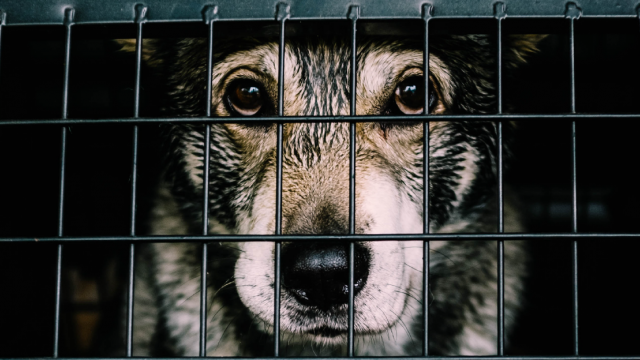Approximately 200,000 dogs are used in experiments around the world every year.
Most are now bred in facilities, but this still involves immense suffering in crowded, noisy conditions, often with no or limited outdoor access, socialisation or exercise opportunities. Many are transported over long distances in planes and trucks, sometimes across the world.
Sadly, in the UK, 2020 figures show that the use of dogs in experiments has decreased by only 5% over the past decade. This is despite significant strides forward in animal-free science over the same period and clear opposition from the public. The Government’s own commissioned Ipsos Mori survey on UK public attitudes to animal testing in 2018 showed that 86% of people find it unacceptable to test on dogs for the purpose of medical research, even where that research is said to be for the benefit of human health.
In the European Union, 22% of dogs used for the first time in experiments in 2018 were born outside Europe. Between 2017 and 2018, dogs were used 25,722 times in experiments in the EU. These experiments were carried out in 18 member states, with the UK, France and Germany recording the highest numbers.
Approximately 60,000 dogs are used in experiments in the US every year.
For dogs in certain countries, the situation is even worse: stray and sheltered dogs are still being used in experiments.
Stray and sheltered dogs
Our research has shown that stray and sheltered dogs, or those labelled as “random source”, can still be used in experiments in countries including the USA, Canada and Australia.
In some parts of the USA and Canada, local laws actually allow laboratories to buy unclaimed dogs from animal shelters for use in painful experiments.
We found shocking evidence that, around the world, stray dogs are being deliberately harmed or killed for educational purposes, including for students to develop and practice their surgical skills at human and veterinary medical schools.
In Brazil, we found evidence that lost, stray and abandoned dogs who’ve ended up in government-run shelters were being handed over to universities for use in experiments. And many of these poor animals were also being supplied to veterinary schools for student teaching classes.
Our investigation team discovered in Thailand that vet students at Khon Kaen University, one of the country’s leading universities, were using street dogs to practise their surgery skills.
And our investigation in Japan revealed that hundreds of dogs were being deliberately harmed or killed for educational purposes, including for use in anatomy and physiology classes or for veterinary students to develop and practise their clinical and surgical skills. We made the heart-breaking discovery that dogs were subjected to multiple unnecessary surgeries, repeatedly cut open and stitched up.
Use of dogs in veterinary education
Treating dogs as disposable commodities and viewing them simply as teaching tools with no regard for their lives is morally wrong. But we believe it’s also scientifically and educationally unnecessary. There are many viable alternatives to using dogs in teaching, and many schools around the world are successfully using a combination of simulations, models and actual animal patients instead.
In recent years, there has been growing awareness by the veterinary educational profession of the unethical practice of inflicting deliberate harm on animals to train veterinarians. Cruelty Free International believes that aspiring veterinarians should not have to use animals as learning tools and instead should foster meaningful regard for their lives.
Many human and veterinary medical schools around the world are moving away from purposefully harming and killing animals to train students. Their programmes, considered to be humane, progressive and effective, employ a combination of highly effective alternatives, including simulations and models. This approach for surgical training has been shown to be far superior to the traditional, outdated practice of using and killing animals.
Examples of models and manikins that allow veterinary students to practise and refine skills and techniques include:
- Rescue Critters—animal manikins used to teach clinical skills such as suture ties, injections, blood sampling and placing a urinary catheter
- DASIE (Dog Abdominal Surrogate for Instructional Exercises)—used to teach abdominal surgery
- A realistic model produced by SynDaver that can replace the use of live dogs in surgical skills training. Each simulator is anatomically correct and contains lifelike bones, muscles and joints. The "dog" breathes, has a heartbeat and can be programmed to simulate various diseases and medical complications. The model even has a circulatory system and the skin bleeds when surgical cuts are made.
Rehoming
For most dogs, the end of the experiment usually means the end of their life as researchers inspect their bodies for the damage they have caused. Some dogs, however, could be rehomed, but facilities are not motivated enough to try.
Our investigation of UK laboratory MSD in 2014 found that dogs were being killed rather than being rehomed. Luckily, the investigator was able to persuade the laboratory to release two of the female beagles who had been used for breeding. They found forever homes and have been able to live out the rest of their lives in happy, safe environments. Why can’t all dogs have this second chance?

As with all the other mothers, the company wanted to kill Bonnie and Billie. But the Cruelty Free International investigator was able to secure their release. Both Bonnie and Billie were rescued from death and homed.
Around 60,000 dogs are used in experiments in the United States each year, and much of the research is conducted at facilities that receive public funding from the National Institutes of Health. While many animals die as part of these taxpayer-funded studies, some do survive and would be able to recover if given the chance. However, even these survivors may be killed and discarded if they are considered no longer useful to the laboratory. We’re working to change this.
In the absence of federal requirements, twelve states—California, Connecticut, Delaware, Illinois, Maryland, Minnesota, Nevada, New York, Oregon, Rhode Island, Virginia and Washington—have enacted laws governing the post-research placement for dogs and cats used in publicly funded research institutions. A national requirement is needed to ensure that all survivors have a chance to find a loving home.
WHAT WE ARE DOING
We are calling for an end to the use of stray or relinquished dogs in experiments, for any purpose.
We are calling for an end to the use of dogs in medical and veterinary education—there is simply no justification for their continued use with the availability of simulations, models and actual animal patients.
Whilst dogs continue to be used, we are calling for them to be rehomed, where possible.











